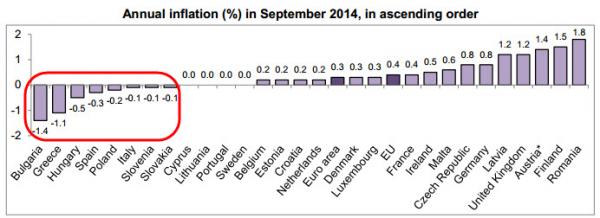歐盟統計局(Eurostat)周四(10月16日)公布的數據顯示,歐元區9月消費者物價指數(CPI)終值年率升幅從8月的0.4%降至0.3%,為2009年10月以來最低水平,符合預期和初值。
具體數據顯示,歐元區9月CPI月率升幅為0.4%,符合預期,8月升幅為0.1%。
歐元區9月核心CPI年率升幅為0.8%,8月升幅為0.7%;9月核心CPI月率升幅為0.5%,8月升幅為0.3%。
更綜合的一組數據顯示,歐盟試圖避免物價持續下跌的努力遭遇挫折。歐盟9月CPI年率上升0.4%,低于8月的0.5%,並且為2009年9月以來的最低同比升幅。
統計數據顯示,8個歐盟成員國CPI年率錄得下降,其中有5個是歐元區成員國,即希臘、西班牙、意大利、斯洛文尼亞和斯洛伐克,另外三個不使用歐元的歐盟成員國是保加利亞、匈牙利和波蘭。
這些數據將很可能加劇投資者對歐洲通縮風險增加的恐懼,這種擔憂情緒使得世界各地資產價格下降。

鑒于通脹率如此低,歐元區難以承受住太多衝擊,例如德國經濟的疲軟或烏克蘭附近的地緣政治緊張局勢,這種衝擊或都使整個歐元區陷入通縮。
歐洲央行(ECB)行長德拉基(Draghi)在今年6月份和9月份均採取措施對抗通縮,兩次降息將利率推至新低,包括存款負利率,並推出新的銀行貸款和購買資產支持證券(ABS)和擔保債券(CB)計劃。
但更加戲劇性的措施並不完全一致,美聯儲(FED)採取很少的貨幣刺激措施,英國央行(BOE)和日本央行(BOJ)已經開始大規模地購買政府債券來增加貨幣供應量。
歐盟統計局公布的其他數據顯示,歐元區8月國內需求疲軟。盡管歐元區貿易順差擴大至92億歐元(116美元),2013年8月為73億歐元。季調後貿易帳增長是受進口下降推動而不是因為出口回升。的確,出口從7月下跌0.9%,為連續第三個月下跌,而進口下跌3.1%。
出口下降對歐元區經濟而言是個壞消息,其在第二季度依靠貿易避開緊縮。伴隨著高失業率和低薪資增長,政府財政緊縮計劃依舊保持內需疲軟,許多企業已經開始在歐元區以外地區投資。
But there is little consensus for more-dramatic measures--the kind of monetary stimulus the Fed, the Bank of England and the Bank of Japan have deployed--namely large-scale purchases of government bonds to raise the money supply.
There was a small sliver of good news in Thursday's figures. In its preliminary estimate, Eurostat had calculated that the core rate of inflation for the eurozone--which strips out volatile items such as energy and food--had fallen to 0.7% from 0.9% in August.
Speaking in his monthly press conference, Mr. Draghi acknowledged that was a worry, since it indicated the downward pressure on prices had spread beyond food and energy and may increasingly reflect weak domestic demand. But Eurostat Wednesday raised its estimate of core inflation to 0.8%.
Other figures released by Eurostat pointed to a weakening of domestic demand in August. Although the eurozone's trade surplus widened to 9.2 billion euros ($11.68 billion) from EUR7.3 billion in August 2013, seasonally adjusted figures showed that was driven by a decline in imports rather than a pickup in exports. Indeed, exports fell 0.9% from July, the third straight month of decline, while imports fell by 3.1%.
The decline in exports is bad news for the eurozone economy, which relied on trade to help stave off a contraction in the second quarter. With high unemployment, low growth in wages and government austerity programs still keeping domestic demand anemic, many businesses have had to look outside the currency area.
[責任編輯: 林天泉]